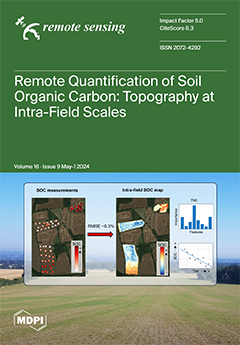Interactions between carbon (C), nitrogen (N), and phosphorus (P), the vital indicators of ecological restoration, play an important role in signaling the health of ecosystems. Rapidly and accurately mapping foliar C, N, and P is essential for interpreting community structure, nutrient limitation, and
[...] Read more.
Interactions between carbon (C), nitrogen (N), and phosphorus (P), the vital indicators of ecological restoration, play an important role in signaling the health of ecosystems. Rapidly and accurately mapping foliar C, N, and P is essential for interpreting community structure, nutrient limitation, and primary production during ecosystem recovery. However, research on how to rapidly map C, N, and P in restored areas with mixed plant communities is limited. This study employed laser imaging, detection, and ranging (LiDAR) and hyperspectral data to extract spectral, textural, and height features of vegetation as well as vegetation indices and structural parameters. Causal band, multiple linear regression, and random forest models were developed and tested in a restored area in northern China. Important parameters were identified including (1), for C, red-edge bands, canopy height, and vegetation structure; for N, textural features, height percentile of 40–95%, and vegetation structure; for P, spectral features, height percentile of 80%, and 1 m foliage height diversity. (2) R
2 was used to compare the accuracy of the three models as follows: R
2 values for C were 0.07, 0.42, and 0.56, for N they were 0.20, 0.48, and 0.53, and for P they were 0.32, 0.39, and 0.44; the random forest model demonstrated the highest accuracy. (3) The accuracy of the concentration estimates could be ranked as C > N > P. (4) The inclusion of LiDAR features significantly improved the accuracy of the C concentration estimation, with increases of 22.20% and 47.30% in the multiple linear regression and random forest models, respectively, although the inclusion of LiDAR features did not notably enhance the accuracy of the N and P concentration estimates. Therefore, LiDAR and hyperspectral data can be used to effectively map C, N, and P concentrations in a mixed plant community in a restored area, revealing their heterogeneity in terms of species and spatial distribution. Future efforts should involve the use of hyperspectral data with additional bands and a more detailed classification of plant communities. The application of this information will be useful for analyzing C, N, and P limitations, and for planning for the maintenance of restored plant communities.
Full article





